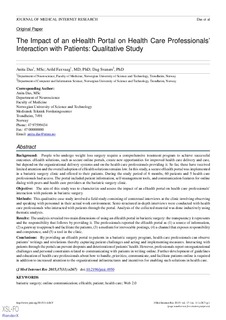| dc.description.abstract | Background: People who undergo weight loss surgery require a comprehensive treatment program to achieve successful outcomes. eHealth solutions, such as secure online portals, create new opportunities for improved health care delivery and care, but depend on the organizational delivery systems and on the health care professionals providing it. So far, these have received limited attention and the overall adoption of eHealth solutions remains low. In this study, a secure eHealth portal was implemented in a bariatric surgery clinic and offered to their patients. During the study period of 6 months, 60 patients and 5 health care professionals had access. The portal included patient information, self-management tools, and communication features for online dialog with peers and health care providers at the bariatric surgery clinic.
Objective: The aim of this study was to characterize and assess the impact of an eHealth portal on health care professionals’ interaction with patients in bariatric surgery.
Methods: This qualitative case study involved a field study consisting of contextual interviews at the clinic involving observing and speaking with personnel in their actual work environment. Semi-structured in-depth interviews were conducted with health care professionals who interacted with patients through the portal. Analysis of the collected material was done inductively using thematic analysis.
Results: The analysis revealed two main dimensions of using an eHealth portal in bariatric surgery: the transparency it represents and the responsibility that follows by providing it. The professionals reported the eHealth portal as (1) a source of information, (2) a gateway to approach and facilitate the patients, (3) a medium for irrevocable postings, (4) a channel that exposes responsibility and competence, and (5) a tool in the clinic.
Conclusions: By providing an eHealth portal to patients in a bariatric surgery program, health care professionals can observe patients’ writings and revelations thereby capturing patient challenges and acting and implementing measures. Interacting with patients through the portal can prevent dropouts and deterioration of patients’ health. However, professionals report on organizational challenges and personal constraints related to communicating with patients in writing online. Further development of guidelines and education of health care professionals about how to handle, prioritize, communicate, and facilitate patients online is required in addition to increased attention to the organizational infrastructures and incentives for enabling such solutions in health care. | nb_NO |
